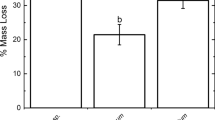Abstract
The contents of phospholipids and carbon of the total microbial biomass were determined in the modern chestnut soil and in the paleosols buried under mounds of the Bronze and Early Iron Ages (5000–1800 years ago) in the dry steppe of the Lower Volga River basin. Judging from data on the ratio between the contents of phospholipids and organic carbon in the microbial cells, the carbon content of the living microbial biomass was calculated and compared with the total microbial biomass and total organic carbon in the studied soils. In the background chestnut soil, the content of phospholipids in the A1, B1, and B2 horizons amounted to 452, 205, and 189 nmol/g, respectively; in the paleosols, it was 28–130% of the present-day level. The maximum content was measured in the paleosols buried 5000 and 2000 years ago, in the periods with an increased humidity of the climate. In the background chestnut soil, the total microbial biomass was estimated at 5680 (the A1 horizon), 3380 (B1), and 4250 (B2) μg C/g; in the paleosols, it was by 2.5–7.0 times lower. In the upper horizons of the background soil, the portion of the living microbial biomass in the total biomass was much less than that in the paleosols under the burial mounds; it varied within 8.5–15.3% and 15–81%, respectively. The portion of living microbial biomass in the total organic carbon content of the background chestnut soil was about 4–8%. In the paleosols buried in the Early Iron Age (2000 and 1800 years ago), this value did not exceed 3–8%; in the paleosols of the Bronze Age (5000–4000 years ago), it reached 40% of the total organic carbon.
Similar content being viewed by others
References
M. B. Vainshtein and E. B. Kudryashova, “On Nanobacteria,” Mikrobiologiya, No. 2, 163–174 (2000) [Microbiology, 69 (2), 129–138 (2000)].
V. A. Demkin, A. V. Borisov, T. S. Demkina, et al., Volga-Don Steppes in the Ancient Past and in the Middle Ages (Synchrobook, Pushchino, 2010) [in Russian].
V. A. Demkin, T. S. Demkina, A. O. Alekseev, et al., Paleosols and Climate of the Lower Volga Steppes in the 1st-4th Centuries AD (ONTI PNTs RAN, Pushchino, 2009) [in Russian].
V. A. Demkin, N. N. Kashirskaya, T. S. Demkina, et al., “Paleosol Studies of Burial Mounds in the Ilovlya River Valley (the Privolzhskaya Upland),” Pochvovedenie, No. 2, 133–145 (2008) [Eur. Soil Sci. 41 (2), 115–127 (2008)].
N. N. Kashirskaya, T. E. Khomutova, T. S. Demkina, and V. A. Demkin, “The Microbial Biomass in Paleosols Buried under Kurgans and in Recent Soils in the Steppe Zone of the Lower Volga Region,” Pochvovedenie, No. 5, 581–587 (2009) [Eur. Soil Sci. 42 (5), 536–542 (2009)].
N. N. Kashirskaya, T. E. Khomutova, V. V. Dmitriev, et al., “The Morphology of Cells and the Biomass of Microorganisms in the Buried Paleosols and Modern Steppe Soils of the Lower Volga Region,” Pochvovedenie, No. 10, 1229–1238 (2010) [Eur. Soil Sci. 43 (10), 1140–1149 (2010)].
I. V. Sergatskov, “Kurgans near the Avilov Settlement in the Lower Reaches of the Ilovlya River,” in Materials on Archaeology of Volga-Don Steppes, No. 2, 4–54 (Izd. VolGU, Volgograd, 2004) [in Russian].
A. S. Skripkin, History of Volgograd Land before the Foundation of the City of Volgograd (Izd. VolGU, Volgograd, 2005) [in Russian].
T. E. Khomutova, T. S. Demkina, and V. A. Demkin, “Estimation of the Total and Active Microbial Biomasses in Buried Subkurgan Paleosols of Different Ages,” Mikrobiologiya 73(2), 241–247 (2004) [Microbiology, 73 (2), 196–201 (2004)].
R. Findlay, “The Use of Phospholipid Fatty Acids to Determine Microbial Community Structure,” in Molecular Microbial Ecology Manual, 1–17 (1996).
R. H. Findlay, G. M. King, and L. Watling, “Efficacy of Phospholipid Analysis in Determining Microbial Biomass in Sediments,” Appl. Environ. Microbiol. 55(11), 2888–2893 (1989).
A. Frostegard, A. Tunlid, and E. Baath, “Microbial Biomass Measured as Total Lipid Phosphate in Soils of Different Organic Content,” J. Microbiol. Meth. 14, 151–163 (1991).
T. K. Rajaniemi and V. J. Allison, “Abiotic Conditions and Plant Cover Differentially Affect Microbial Biomass and Community Composition on the Dune Gradients,” Soil Biol. Biochem. 4, 102–109 (2009).
J. Steinberg, L. Zelles, Q. Y. Bai, et al., “Phospholipid Fatty Acid Profiles as Indicators for the Microbial Community Structure in Soils along a Climatic Transect in the Judean Desert,” Biol. Fertil. Soils 28, 292–300 (1999).
Author information
Authors and Affiliations
Corresponding author
Additional information
Original Russian Text © T.E. Khomutova, N.N. Kashirskaya, V.A. Demkin, 2011, published in Pochvovedenie, 2011, No. 12, pp. 1496–1503.
Rights and permissions
About this article
Cite this article
Khomutova, T.E., Kashirskaya, N.N. & Demkin, V.A. Assessment of the living and total biomass of microbial communities in the background chestnut soil and in the paleosols under burial mounds. Eurasian Soil Sc. 44, 1373–1380 (2011). https://doi.org/10.1134/S1064229311120064
Received:
Published:
Issue Date:
DOI: https://doi.org/10.1134/S1064229311120064




